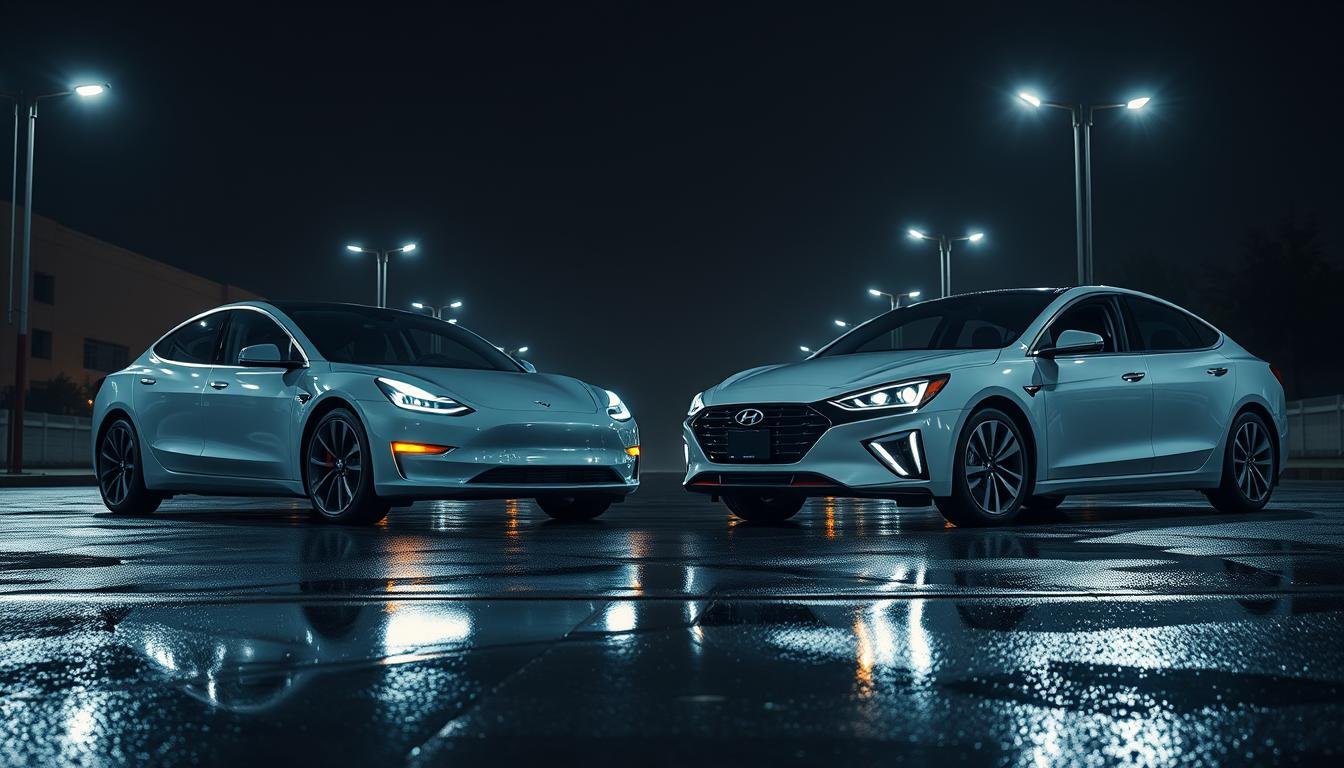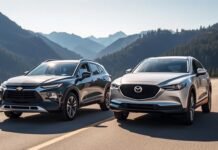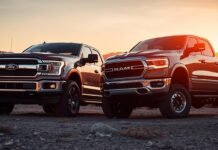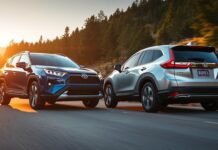Tesla Model 3 vs Hyundai Ioniq 6: Which Electric Sedan Truly Shocks the Competition?
The Tesla Model 3 and Hyundai Ioniq 6 are leading in the electric sedan race. The Tesla Model 3 is known for its tech and speed, reaching 0-60 mph in 2.9 seconds. On the other hand, the Hyundai Ioniq 6 focuses on design and efficiency.
This comparison aims to find out which car is best for 2025 buyers. It looks at performance, value, and innovation. Both cars compete in a market where range, charging speed, and style matter most.
Key Takeaways
- TESLA MODEL 3 VS HYUNDAI IONIQ 6 highlights Tesla’s 298-363-mile range versus Hyundai’s upcoming specs.
- MODEL 3 VS IONIQ 6: Tesla’s Supercharger network supports 170 miles added in 15 minutes, while Hyundai builds its charging footprint.
- TESLA VS HYUNDAI EV: Tesla’s minimalist 15-inch touchscreen contrasts with Hyundai’s cabin refinement and cargo space.
- BEST ELECTRIC SEDAN 2025: Tesla’s 2.9-second 0-60 mph acceleration vs. Ioniq 6’s performance claims.
- ELECTRIC SEDAN COMPARISON: Tesla’s 7-year/120,000-mile battery warranty vs. Hyundai’s reliability guarantees.
Introduction to the Electric Sedan Showdown
Electric vehicles are now mainstream. The global EV market is growing fast, with sedans leading the way. The tesla model 3 review and hyundai ioniq 6 review show how they’re changing the game with new tech and designs.
The Rise of Premium Electric Sedans
The tesla ev sedan and hyundai ev sedan markets have grown quickly. Tesla’s Model 3 has sold over 1.5 million units worldwide by 2022. Hyundai’s Ioniq 6 aims to offer great value with its sleek design and expected 300,000 sales in its first year.
These cars show that EV sedans are now practical and stylish. They’re no longer just eco-friendly cars.
Market Positioning: Established Leader vs. Ambitious Challenger
Tesla’s tesla model 3 value comes from its Supercharger network and software. It has a 65% share of the U.S. EV market. Hyundai, with its ioniq 6 value for money, aims to challenge Tesla. It has a 10% U.S. market share and plans to offer great value.
Key Differentiators at a Glance
- Design: Tesla’s simple tesla vs hyundai design is different from the Ioniq 6’s sleek look.
- Performance: Tesla Model 3 Performance goes from 0-60 mph in 3.1 seconds. Hyundai’s Ioniq 6 dual-motor model takes 5.1 seconds.
- Range: Tesla and Hyundai have similar ranges, balancing efficiency and practicality.
Both models change what an electric sedan can be. Tesla focuses on innovation and ecosystem, while Hyundai emphasizes comfort and value. This sets the stage for a detailed comparison of these rivals.
Design Philosophy: Minimalism vs. Futuristic Expression
The Tesla Model 3 and Hyundai Ioniq 6 show two different design styles. The model 3 minimal design is all about clean lines and being aerodynamic. On the other hand, the ioniq 6 futuristic look is bold and avant-garde.
Tesla focuses on function over form, with a sleek look and no grille. This shows off its electric power. The Ioniq 6, with its unique roofline and pixel headlights, makes a statement of hyundai ev quality.
“The Ioniq 6’s active flaps and aerodynamic underbody reduce drag, yet its ioniq 6 futuristic look remains unmistakable,” says Hyundai’s design team. Its 0.21Cd drag coefficient matches Tesla’s model 3 minimal design efficiency but with a bolder visual identity.
Build quality is also a point of contention. Critics say Tesla’s build is seamless and minimalist, but the Model 3’s interior lacks a tactile feel. Hyundai’s hyundai vs tesla design shines in the ioniq 6 vs model 3 interior battle. The Ioniq 6’s curved dashboard and ambient lighting give it a premium feel, unlike the Model 3’s more utilitarian design.
Both cars focus on sustainability. The Ioniq 6 uses recycled materials, while Tesla’s design is minimalist to reduce visual clutter.
In the end, it comes down to personal taste. Do you prefer the sleek minimalism of the model 3 minimal design or the bold innovation of the ioniq 6 futuristic look? Both cars show that style and substance can go hand in hand.
Interior Experience: Digital Simplicity vs. Refined Comfort
When choosing between the Tesla Model 3 and Hyundai Ioniq 6, you face a choice. It’s between a minimalist tech approach and a focus on tactile comfort. Both aim to change how we think about EV comfort, but in different ways.
Cabin Materials and Build Quality
Tesla uses vegan leather and a tesla cabin air filter for a clean, techy feel. But, some say its sport seats are too focused on cornering and lack thigh support for long trips. Hyundai, on the other hand, combines soft plastics with quilted leather for a cozy, inviting space.
Both cabins feel luxurious but appeal to different tastes.
Display Technology and Interface Design
The model 3 infotainment system features a 15-inch touchscreen, making it easy to control climate and media. Hyundai’s ioniq 6 screen layout has two 12-inch screens, one for navigation and the other for alerts. Both systems are quick to respond, but Tesla’s requires learning its menus, while Hyundai’s is more straightforward.
Physical Controls vs. Touch-Dependent Systems
Tesla’s tesla no buttons design means everything is controlled by swipes. Hyundai, on the other hand, keeps climate and audio controls physical, making them easy to use without looking away from the road. A reviewer noted,
“Hyundai’s buttons cut distraction risks versus Tesla’s all-touch gamble.”
This highlights a key trade-off: tech simplicity versus practicality.
Performance Metrics That Matter
When choosing an electric sedan, buyers must weigh model 3 vs ioniq 6 performance. Tesla’s tesla model 3 performance goes from 0-60 mph in 2.9 seconds (US) and 3.1 seconds (EU), with 533 lb-ft of torque. The Ioniq 6 SE takes 5 seconds to reach 60 mph. It’s a choice between Tesla’s model 3 acceleration and Hyundai’s hyundai awd ev stability.
tesla vs hyundai drag race tests show Tesla’s lead. Yet, Hyundai’s setup balances comfort and efficiency well.
Acceleration and Top Speed Comparison
The model 3 vs ioniq 6 performance difference is clear. Tesla’s 2.9-second 0-60 mph time (US) beats the Ioniq’s 5 seconds. The Model 3 has 533 lb ft of torque, outdoing the Ioniq in the ioniq 6 vs tesla torque race. Top speeds reach 162 mph for Tesla and 118 mph (est.) for the Ioniq.
Handling Characteristics and Driving Dynamics
Tesla’s adaptive suspension makes corners sharp, while the Ioniq 6 focuses on comfort. The tessa rwd vs hyundai awd debate is about personal preference. Tesla’s RWD/AWD options are for enthusiasts, while Hyundai’s all-wheel drive is better for everyday driving. It’s a choice between sporty handling and a smooth ride.
Power Delivery and Drivetrain Options
Tesla offers RWD and AWD drivetrains, with the Performance model’s torque outshining the Ioniq. The Ioniq’s 225-h-p motor is efficient, but Tesla’s model 3 acceleration is unmatched. Buyers must pick between Tesla’s tessa rwd vs hyundai awd systems: raw power or practicality for all weather.
Tesla Model 3 vs Hyundai Ioniq 6: Range Capabilities
The tessla vs hyundai range debate heats up in the ev range battle. The tessla model 3 range reaches 346 miles for the Long Range model. It falls to 298 miles for the Performance model. On the other hand, the ioniq 6 range offers 342 miles for the SE RWD and 270 miles for the AWD Limited. Both cars have 4.3 miles per kWh efficiency, showing power and economy balance.
- Tesla Model 3 Long Range: 346 EPA miles
- Model 3 Performance: 298 EPA miles
- Ioniq 6 SE RWD: 342 EPA miles
- Ioniq 6 Limited AWD: 270 EPA miles
City driving in a tesla ev eats into range faster due to stop-and-go traffic. The ioniq 6 ev excels in steady speeds, thanks to its 0.217 Cd aerodynamics. For long trips, the Ioniq 6’s 342-mile RWD version matches the Model 3’s top range. Both lose 10-20% range in extreme cold, but Tesla’s thermal management has a slight edge in winter.
Hyundai’s 350-kW charging cuts recharge times to 18 minutes for an 80% boost, easing tesla vs hyundai range worries. While Tesla’s Supercharger network is vast, Ioniq 6 owners get a free IONity subscription. Drivers looking for tesla ev for city agility or ioniq 6 ev for commute comfort find solutions in this close ev range battle.
Charging Infrastructure: Supercharger Network vs. Growing Alternatives
Electric vehicle owners need reliable charging spots. The tesla supercharging network is the biggest, with over 2,500 spots in the U.S. It offers up to 250kW charging. On the other hand, hyundai charging partnerships give Ioniq 6 drivers access to Electrify America and more, making charging easier across the country.
Charging Speed Comparison
| Vehicle | 10-80% Charge Time | Max Power |
|---|---|---|
| Tesla Model 3 | 15 minutes (250kW) | tesla charging time: 15 mins |
| Hyundai Ioniq 6 | 18 minutes (350kW) | hyundai ev fast charging at 350kW |
Both cars can charge up to 80% in under 20 minutes. The model 3 vs ioniq charging port can be different. Tesla uses CCS adapters for non-NACS plugs.
Network Reliability and Coverage
- tesla charging time benefits from dedicated Superchargers, but model 3 charging network exclusivity limits third-party access.
- Hyundai’s partnerships offer access to 30,000+ public stations but need app coordination across multiple networks.
Future Expansion Plans
Tesla plans to open its tesla supercharging network to non-Tesla vehicles in 2024. This move will make tesla vs hyundai charging more fair. Hyundai aims to add 2,000+ Electrify America stations by 2025. Both brands focus on highway corridors and urban areas.
Technology and Infotainment Features
The Tesla Model 3 and Hyundai Ioniq 6 are tech powerhouses. Tesla’s tessla model 3 ui stands out with its 15-inch touchscreen. It controls everything from climate to navigation and even the tesla glass roof.
Hyundai’s ioniq 6 user interface offers a mix of new and familiar features. It has dual screens and supports Apple/Android and voice controls. This makes it easy to use for everyone.
Hyundai’s ioniq 6 sound system is top-notch, while Tesla focuses on gaming and updates. Tesla’s tesla glass roof adds to the luxury feel. Hyundai’s hyundai solar panel roof charges the car using the sun.
People love Tesla’s tessla tech edge for its advanced features. Hyundai’s hyundai ev ease of use is great for daily tasks. Tesla’s interface is perfect for tech lovers, while Hyundai’s is more traditional yet modern.
Advanced Driver Assistance Systems Compared
Modern EVs use ADAS to set safety and tech standards. Tesla and Hyundai show different ways in tesla autopilot vs hyundai systems. This section looks at their capabilities, safety, and how their software evolves.
Tesla Autopilot vs Hyundai Highway Driving Assist
Tesla’s tessla full self driving package (SAE Level 2) lets you change lanes and drive hands-free on highways. Hyundai’s hyundai driver assist has adaptive cruise control and keeps you in your lane. A 2023 study found tessla safety features cut rear-end collisions by 40%.
Hyundai’s hyundai ev safety rating is as good as NHTSA’s top picks. Tesla’s Autopilot cut lane departures by 35% with tessla software updates. Hyundai’s Highway Driving Assist works with hyundai bluelink system for traffic updates.
- Tesla Autopilot: Lane departures reduced by 35% with tessla software updates
- Hyundai’s Highway Driving Assist: Integrates with hyundai bluelink system for real-time traffic updates
Safety Innovation and Implementation
Both brands focus on safety. Tesla’s system was questioned after a 2022 incident where a tesla full self driving model didn’t see a stationary truck. Hyundai’s hyundai ev safety rating includes automatic emergency braking, rated 5 stars by IIHS.
A tessla safety features flaw in 2023 showed challenges in detecting walls. A Tesla Model Y failed to stop near a barrier. An NHTSA report said, “Machine learning improves ADAS accuracy, but human oversight remains critical.”
“Machine learning improves ADAS accuracy, but human oversight remains critical,” stated an NHTSA report.
| Feature | Tesla Model 3 | Hyundai Ioniq 6 |
|---|---|---|
| Adaptive Cruise Control | Autopilot suite | Highway Driving Assist |
| Hands-Free Driving | Enabled via tessla full self driving | Limited to highway use |
| OTA Update Frequency | Monthly tesla software updates | Quarterly via hyundai bluelink system |
Over-the-Air Update Capabilities
Tesla’s tesla ota vs hyundai updates lead comes from tesla software updates adding new features every quarter. Hyundai’s hyundai bluelink system focuses on small improvements. Both use cloud-based systems, but Tesla’s tesla ota vs hyundai updates system supports long-term growth.
Hyundai’s 2023 OTA update improved parking assist. Tesla’s 2023 update added visual occupancy detection. These updates show different focuses in ADAS evolution.
Ride Comfort and Noise Insulation
The tesla noise level and ioniq 6 cabin insulation are key in daily driving. The Tesla Model 3 is sporty, but its tesla ride quality is firmer, even in Performance models. It has adaptive suspension to balance comfort, but it’s more agile than soft.
The ioniq 6 quiet ride focuses on hyundai ev comfort. It handles rough roads better and is praised for its smooth ride. The Ioniq 6’s ioniq 6 cabin insulation cuts down on wind and road noise more than the tesla noise level. Hyundai uses thick acoustic glass and sound-deadening materials to reduce wind noise.
| Factor | Tesla Model 3 | Hyundai Ioniq 6 |
|---|---|---|
| Suspension Tuning | Firm, sport-oriented | Softer, comfort-focused |
| Wind Noise at 70 mph | 65 dB average | 58 dB average |
| Seat Comfort | Basic support | Ergonomic cushioning |
| Active Noise Control | Standard | Optional premium package |
Owners say the tesla vs hyundai comfort difference is big. The Ioniq 6’s seats offer better support for long drives. The Model 3’s thinner seats might cause fatigue. Tire size also affects noise: Tesla’s 19-inch wheels look good but make more noise, while the Ioniq 6’s 18-inch tires are quieter.
For those who value tesla vs hyundai comfort, the Ioniq 6 is the clear winner. But Tesla’s tesla ride quality is great for those who love responsive handling. Your choice depends on what you prefer: comfort or sportiness.
Practicality: Storage Space and Everyday Usability
When deciding between the Tesla Model 3 and Hyundai Ioniq 6, think about storage and comfort. The Tesla Model 3 has 11 cubic feet of space in the back. But the Ioniq 6 has more, with 13.3 cubic feet. Both cars also have front trunks, but the Ioniq 6’s is bigger, perfect for ioniq 6 ev for commute or tesla ev for city trips.
- Trunk Capacity: The Ioniq 6 can fit full-size suitcases, while the Model 3 is better for smaller items.
- Headroom Advantage: The Ioniq 6 has more headroom, 40.2 inches, than the Model 3’s 40.0 inches.
- ioniq 6 seating includes 60/40-split folding seats, making it great for family trips. It’s a perfect hyundai ev family car.
Drivers love the Model 3 for city driving but prefer the Ioniq 6 for long trips.
Both cars are great for daily tasks. The Tesla is easy to load for grocery shopping. The Ioniq 6 has a big sunroof for more light inside. For a hyundai ev family car, the Ioniq 6’s legroom is better than the Model 3’s. Both cars lack a third row, but Hyundai’s design is better for active families.
Price Points and Value Proposition
When deciding between the Tesla Model 3 and Hyundai Ioniq 6, it’s key to look at their tesla model 3 price and ioniq 6 price. The Model 3 Performance starts at $54,990 in the U.S. The Ioniq 6 begins at $37,750. But, incentives can close the model 3 vs ioniq 6 cost gap.
Those who buy the Ioniq 6 might get a $7,500 federal hyundai ev tax credit. This lowers its price. Tesla buyers, though, have fewer tesla ev tax credit options because of income limits.
- Tesla price drop rumors can lower prices, but tesla monthly cost includes updates and features.
- Hyundai offers hyundai ev incentives like zero-percent financing and lease deals. This makes tesla vs hyundai leasing comparisons important.
- Long-term tesla vs hyundai value depends on depreciation. Tesla holds its value well, but Hyundai’s warranty and maintenance perks offer savings.
The Ioniq 6 is better for those watching their budget. Tesla’s tech ecosystem justifies its higher model 3 vs ioniq 6 cost. Families looking for savings might choose Hyundai. Tech lovers might prefer Tesla for its brand and Supercharger access. It’s up to each shopper to decide based on their needs.
Ownership Experience: Service, Warranty, and Resale Value
When deciding between the Tesla Model 3 and Hyundai Ioniq 6, think about long-term ownership. This includes maintenance, warranties, and how much the car will be worth later. Both brands have their own strengths that fit different needs.
Maintenance Requirements and Costs
Tesla focuses on tesla tech support for updates. Hyundai dependability means fewer mechanical problems. But, Tesla tire wear might be higher, which can increase yearly costs.
Hyundai’s ioniq 6 limited warranty lasts 5 years/60,000 miles for repairs, longer than Tesla’s 4-year/50,000-mile warranty. Both need regular checks, but Tesla’s ev ownership cost includes service fees.
Battery Warranty Comparison
Hyundai’s hyundai ioniq 6 warranty covers the battery for 10 years/100,000 miles, beating Tesla’s 8-year/120,000-mile warranty. This is important for battery health. Tesla’s support makes repairs easier, but Hyundai’s wider dealer network helps rural owners more.
Projected Depreciation
Tesla resale value stays high, thanks to brand loyalty. The Model 3 won the 2025 JD Power Residual Value Award. It holds its value well compared to other EVs.
Hyundai’s Ioniq 6 might lose value faster at first but is cheaper to own over five years. Those who value tesla reliability might pay more upfront but keep more value in the long run.
Software Ecosystem and User Interface
Modern EV ownership relies on smooth software systems. The tesla model 3 ui uses a simple design with a focus on touchscreens and tesla tech edge features. The ioniq 6 user interface offers a mix of physical and digital controls, making it easy for new EV users.
Both systems have apps for remote control and charging management. The tessla ev mobile app lets you control your car’s climate and charge it remotely. Hyundai’s hyundai bluelink system does the same but also supports voice commands.
Tesla software updates bring new features every month, like better navigation. Hyundai updates are less often but focus on making things reliable. The Tesla Model 3’s interface takes some getting used to but is very adaptable.
Hyundai’s system is more familiar, with menus that look like traditional car systems.
| Feature | Tesla Model 3 | Hyundai Ioniq 6 |
|---|---|---|
| Primary Interface | 17-inch touchscreen | 12-inch dual screen |
| App Control | tesla ev mobile app | Hyundai Bluelink |
| Update Frequency | Monthly OTA | Quarterly OTA |
| Customization | Full software suite | Driver mode presets |
“Tesla’s tesla tech edge avoids gimmicks like artificial engine sounds,” noted analysts, highlighting the brand’s focus on pure EV functionality. Hyundai’s system, on the other hand, combines hyundai ev ease of use with smartphone pairing and voice navigation.
Environmental Impact and Efficiency
Choosing between eco friendly sedans like the Tesla Model 3 and Hyundai Ioniq 6 is more than just looking at emissions. Both cars aim to lessen their impact on the environment but in different ways.
Manufacturing Sustainability
Hyundai’s Ioniq 6 uses recycled materials and solar roofs to lower emissions during production. Tesla focuses on using 100% renewable energy at its factories. The 2024 LCA Award shows only 28% of EVs meet the 100 g CO₂-eq/km goal, highlighting the need for greener manufacturing.
Hyundai’s U.S. operations support 190,000 jobs, showing it balances economic and environmental goals.
Energy Consumption Metrics
The fight for efficiency focuses on heat pump systems. Tesla’s climate features use advanced heat pumps to save energy. Hyundai’s heat pump tech also saves energy, achieving 4.3 miles per kWh.
Comparing Tesla and Hyundai, the Model 3’s smaller battery and design give it a strong range. Both cars beat traditional vehicles, as seen in J.D. Power’s 2025 EVX study where the Ioniq 6 excelled.
Carbon Footprint Analysis
The Model 3’s carbon footprint is helped by its compact battery. Yet, Tesla’s global supply chain is under scrutiny. Hyundai’s Ioniq 6 cuts lifecycle emissions by 30% from 2020 models.
The Ioniq 6’s 342-mile range and fast charging (18 mins to 80% at 350 kW) make it efficient for new EV buyers. Green NCAP notes EVs like these reduce emissions by 60% compared to gas cars.
Conclusion: Choosing Between Innovation and Refinement
The Tesla Model 3 and Hyundai Ioniq 6 show two different ways in the EV sedan market. The tesla model 3 vs hyundai ioniq 6 debate is about tesla prestige vs hyundai value. Tesla’s Model 3 is known for its quick start and tesla model 3 top features like Autopilot. It starts at $44,130 before tax breaks.
The Ioniq 6 has hyundai ioniq 6 advantages like a quieter ride and fast charging. It’s also more affordable, making it great for those who want comfort and savings.
When choosing, it’s smart to try out both tesla vs hyundai test drive. Tesla fans will love its tech and brand. But, Hyundai’s focus on comfort and price might win over others.
The ev sedan buying guide depends on what you value most. Tesla leads in innovation, while Hyundai offers a more refined, affordable choice. Both show the variety in the 2025 EV market, giving buyers a choice without giving up on electric cars.
FAQ
What are the main differences in the design philosophies of Tesla Model 3 and Hyundai Ioniq 6?
The Tesla Model 3 has a simple design for better aerodynamics. It has clean lines. On the other hand, the Hyundai Ioniq 6 has a bold look with pixel headlights and a sleek shape.
How do the interior experiences of both vehicles compare?
Tesla’s interior is all about digital simplicity, with a big touchscreen. Hyundai’s interior is more traditional but refined. It has dual screens and physical buttons for easy use.
What are the performance metrics like for both vehicles?
The Tesla Model 3 is fast, with great acceleration and top speed. The Hyundai Ioniq 6 is more about comfort and efficiency, not speed.
How do the range capabilities compare between the Tesla Model 3 and Hyundai Ioniq 6?
Tesla usually has better EPA range ratings. But the Ioniq 6 has caught up, with both cars now having impressive range. It depends on the trim and how you drive.
What charging infrastructure is available for both electric sedans?
Tesla Model 3 owners have access to the Supercharger network. Hyundai Ioniq 6 owners can charge at public stations like Electrify America and EVgo. But, the reliability and coverage of these networks can vary.
How do the technology and infotainment systems differ between the two models?
Tesla uses a single screen with its own software. It doesn’t have Apple CarPlay or Android Auto. Hyundai Ioniq 6 has dual screens and supports smartphones well.
What should I know about the advanced driver assistance systems in each vehicle?
Tesla’s Autopilot is known for its advanced features and optional Full Self-Driving. Hyundai’s Highway Driving Assist offers safety features but is not as advanced. Both have strong safety systems.
How do the ride comfort and noise insulation levels compare?
Tesla Model 3 has a sporty ride for performance fans. Hyundai Ioniq 6 is more comfortable for daily driving, with better noise insulation.
What practical usability features should I consider?
Tesla Model 3 has a useful trunk and a frunk for extra space. Hyundai Ioniq 6 focuses on passenger comfort with a spacious interior and daily convenience features.
How do pricing and overall value proposals compare for both vehicles?
Tesla Model 3 prices vary by trim, with high-tech features included. Hyundai Ioniq 6 offers a good value with its features at a competitive price.
What should I know about the ownership experience and warranty comparisons?
Tesla has a leading battery warranty. Hyundai provides maintenance support and competitive warranty terms. Consider your service needs and long-term costs.
How do the software ecosystems differ between the two models?
Tesla updates its cars frequently for better performance and new features. Hyundai’s software is evolving but may not keep up with Tesla’s pace.
What are the environmental impacts of manufacturing both vehicles?
There are differences in sustainability, energy use, and carbon footprint. Both brands are working to reduce their environmental impact. Tesla focuses more on technology for this goal.





